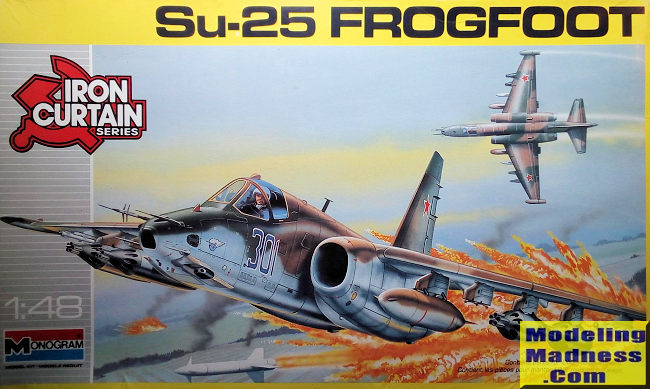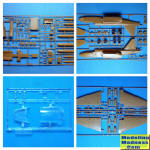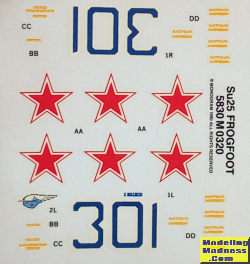
| KIT #: | 5830 |
| PRICE: | €25 in 2005 |
| DECALS: | One option |
| REVIEWER: | Spiros Pendedekas |
| NOTES: |
New tool kit |

| HISTORY |
The Sukhoi Su-25 Grach
(NATO reporting name: Frogfoot) is a subsonic, single-seat, twin-engine jet
aircraft designed to provide close air support for the Soviet Ground Forces. The
first prototype made its maiden flight on 22 February 1975. After testing, the
aircraft went into series production in 1978 at Tbilisi in the Georgian Soviet
Socialist Republic.
Early variants included the Su-25UB two-seat trainer, the Su-25BM for
target-towing, and the Su-25K for export customers. Some aircraft were being
upgraded to Su-25SM standard in 2012. The Su-25T and the Su-25TM (also known as
the Su-39) were further developments, not produced in significant numbers.
Su-25s are in service with Russia, other CIS members, and export customers.
The type has seen combat in several conflicts during its more than 30 years in
service.
| THE KIT |
 Monogram
came in 1990 with a “modern” quarter scale Su-25, which was the company’s first
kit with recessed panel lines. Back then, the available info on the machine was
not that much, with the specific kit design based on one of the prototype
machines. Rendition of some areas like the cockpit and wheel bays was, to a
degree, speculative.
Monogram
came in 1990 with a “modern” quarter scale Su-25, which was the company’s first
kit with recessed panel lines. Back then, the available info on the machine was
not that much, with the specific kit design based on one of the prototype
machines. Rendition of some areas like the cockpit and wheel bays was, to a
degree, speculative.
My example was the first (1990) version with the sprues done in Korea. It comes
in a relatively big, typical Monogram top opening box, with an attractive box
art of two Su-25s performing a strafing mission. Upon opening the box, I was
greeted with 103 light brown styrene pieces, arranged in three equally sized
sprues and sealed in a single bag. Molding was first class, very crisp, with no
flash whatsoever.
External detailing consists of not only very finely recessed panel lines, but
also at places raised riveting, as was observed on the real thing - very nice
indeed! What looks like a pilot’s step is molded “open”, meaning some simple
surgery having to be performed there if you want to display it “closed” and
preserve the fuselage lines. A good amount of additional air scoops (of which
the Su-25 seems to carry many) is provided as well (but not the distinctive one
that was located at the fin base in production machines).
There is a certain
amount of cockpit detail, but it is definitely generic (and, to a certain
degree, speculative), with instrument panel, a simplified K-36L seat with molded
on seat belts, stick, side consoles and a good amount of various details molded
onto the sidewalls. A pilot is also provided, maybe not being a bad idea to
detail paint him and place him in the cockpit, somehow “blanking” the
generic/speculative looks (but do not forget to modify the step into “closed”
position!).
Intakes and exhausts are nicely deep with compressor and turbine faces at their
ends respectively. Landing gear pars look relatively busy, with the wheel
bays exhibiting the same “generic/speculative” looks (and some ejector pin marks
also visible there). Wheels look good, as do the wingtip mounted air brakes (an
interesting feature of the Su-25), that can be posed either “open” or “closed”.
Pylons and ordnance, one of the most distinctive features of the type, look
passable (it is reported that some of them are not carried by production
machines, so check your references!). A supporting rod is also provided, in case
you forget to add weight in this seemingly tail-sitting candidate,
Transparencies are acceptably thin, very clear and superbly molded. The canopy
is split in two and can be displayed open.
 Instructions
are the very comprehensive typical Monogram of the era: coming in the form of a
small pamphlet, they contain a short history, a generic color chart, with the
construction nicely spread in 28 simple and clear steps. Only one scheme is
provided, for “Blue 301”: the specific machine was a prototype (it was exhibited
at Le Bourget Air Show in 1989), presumably being the example Monogram used to
create this kit. Decals look well printed, but their backing paper has yellowed
after 30 years, raising fears that the gluing agent is done.
Instructions
are the very comprehensive typical Monogram of the era: coming in the form of a
small pamphlet, they contain a short history, a generic color chart, with the
construction nicely spread in 28 simple and clear steps. Only one scheme is
provided, for “Blue 301”: the specific machine was a prototype (it was exhibited
at Le Bourget Air Show in 1989), presumably being the example Monogram used to
create this kit. Decals look well printed, but their backing paper has yellowed
after 30 years, raising fears that the gluing agent is done.
Instructions start with putting the cockpit together, then trap it between the
fuselage halves. No weight indication is mentioned, but I would definitely add a
certain amount in front of the cockpit, as to avoid using the supporting rod…).
The nose with the IR sensor is then attached, followed by assembly and
attachment of the intake ducts. Next the main landing gear is built-up and
attached to the main bay wall, with the complete subassembly attached underneath
and “secured” with the lower fuselage frame.
The intake fronts and rear exhausts are next, followed by affixation of the
numerous air scoops and other “bits and pieces” (antennas, fillets). Next is
assembly and installation of the nose landing gear, the wings and the
stabilizers. The wing pylons are subsequently attached underneath the wings,
with ordnance assembly and installation following. Final steps include
assembling and installing the the pilot, affixing the transparencies and the
rest of the tiny bits, for what seems to be a build of average complexity.
| CONCLUSIONS |
Accuracy issues aside
(to a degree understandable, since Monogram worked with whatever info was
available back then), this looks to be a well engineered kit. Since it
represents a prototype, the builder who wishes to depict a later production
machine will have to perform some additions and/or modifications. Molding is
first class and construction looks straightforward. A good number of aftermarket
seems to exist, addressing most of the kit’s lesser areas (like cockpit and
landing gear).
Your other option is the equally old mold OEZ kit, that has been reboxed many
times from many manufacturers (and occasionally updated with new parts),
including (among others) Smer, KoPro, Mistercraft and even Eduard (the latter
with the usual great Eduard extra “goodies”). Though not among the easiest to
put together, this kit has the reputation of resulting in accurate
representation of operational machines.
As a footnote, Kitty Hawk was supposed to have come with both single seat and
dual seat 1/48 Su-25s in 2020, but they were canceled due to the company going
out of business, whereas Zvezda has announced a new tool Frogfoot for 2022!.
Happy modeling!
March 2022
Copyright ModelingMadness.com. All rights reserved. No reproduction in part or in whole without express permission.
If you would like your product reviewed fairly and fairly quickly, please contact the editor or see other details in the Note to Contributors.